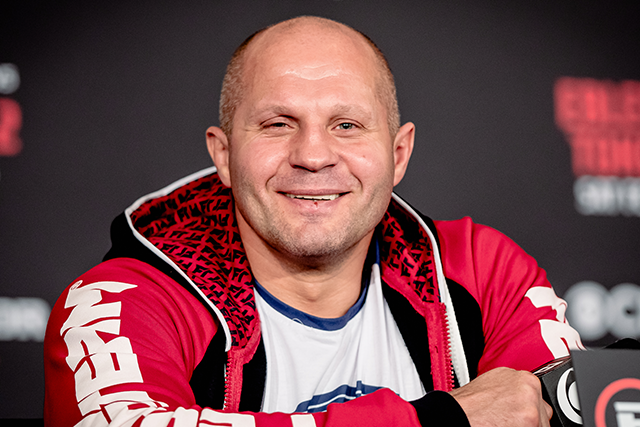Fistic Medicine: Alves and ‘Brain Irregularity’
Matt Pitt Mar 27, 2010

THiago Alves file photo: Dave Mandel/Sherdog.com
If there is a more disturbing word to append to the noun “brain” than “irregularity,” I don’t know it. The preliminary information regarding Thiago Alves’ failure of his pre-fight CAT scan was worrisome; the additional information indicating that the abnormal finding involved an artery in the brain was more worrisome. Medical personnel following the case assumed that the suspicious finding was an aneurysm, possibly a large one. The recent reports that, in fact, Alves does not have an intracranial aneurysm provide reassurance and prompt further questions.
Advertisement
Arteriovenous Malformations (AVM) are tangled collections of blood vessels that can occur anywhere in the body. They are generally benign, but if they compress vital structures or bleed, they can cause significant damage. An intact AVM in the brain might cause headaches, seizures or in an extreme case a swelling of the fluid in the brain known as hydrocephalus. If a cerebral AVM bleeds -- and because these malformed vessels do not have the same structural integrity of normal arteries, they have a high risk of rupture and bleeding -- death occurs in approximately 10 percent of cases.
It is not known if participating in combat sports increases the
risk of bleeding. While in theory the brain trauma associated with
blows to the head or the vascular pressure changes associated with
a choke submission might increase the chance of bleeding, the
definitive data simply does not exist. The New Jersey State
Athletic Control Board made the appropriate conservative decision
to prevent Alves from fighting until his malformation has been
further investigated and treated.
There are several options for treatment of an intracranial AVM, each with benefits and disadvantages depending on where the AVM is located within the brain. By report, Alves’ malformation is in the left hemisphere of his brain, and he is scheduled for an angiogram to delineate exactly what regions of the brain are involved. Once that is determined, a decision will have to be made whether to address the malformation with surgery, radiation or embolization.
Surgery offers the advantage of being able to directly visualize the abnormality and remove it entirely. It has the profound disadvantages of requiring a craniotomy, a prolonged recovery period and possible damage to the brain surrounding the malformed vessels. If the AVM is on a superficial, non-vital portion of the brain, surgery is an option -- otherwise, the results could be catastrophic. Radiation therapy using extremely high energy X-Rays known as gamma rays can be used to burn the malformed vessels. There is some associated damage to surrounding brain tissue, but most patients do very well. Lastly, if the AVM is accessible to a small intra-arterial catheter, it is possible to fill the tangle of blood vessels with a thin Platinum fiber. This embolization procedure clots off the AVM, diminishing the pressure effects on surrounding tissue and ending the risk of hemorrhage.
Once an AVM is treated, there is no reason why a fighter could not return to the ring. Surgery would require a long recovery period, but effective embolization could get a fighter back into the ring within weeks or months. The risk of bleeding or other serious harm would be nil. Once the AVM is dealt with, there is no reason for further care, re-examination or limitation of action. Alves’ future pre-fight CAT scans will always show the presence of an abnormality, but with the stipulation of a neurosurgeon or interventional radiologist to his fitness, his fighting license should be unaffected. Alves has missed a major fight, but if an angiogram proves he does in fact have a manageable AVM, there is no reason -- no medical reason -- he shouldn’t be back in the ring this summer.
The only remaining concern will be the question of whether it was fighting itself, either blows to the head or submission chokes, that caused the apparent AVM. There is no evidence to support the thesis that brain trauma causes AVMs and no reason to suspect that standard choking techniques are implicated in the disease. Far more likely is that the requisite pre-fight CAT scan caught an AVM that otherwise might never have been detected. Or, in a worse case scenario, the pre-fight CAT scan caught an AVM before it ruptured; it may have saved Alves’ life.
While this incident is a hassle for UFC President Dana White and a disappointment for Alves, it is a success story for MMA. The discovery of a potentially dangerous “brain irregularity” stands as a testament to the prudence of the NJSACB and the sport’s interest in fighter safety. Those responsible for the current safety precautions should be congratulated, and those working for greater safety should be encouraged in their efforts.
Matt Pitt is a physician with degrees in biophysics and medicine. He is board-certified in emergency medicine and has post-graduate training in head injuries and multi-system trauma. To ask a question that could be answered in a future article, e-mail him at mpitt@sherdog.com.
Related Articles








